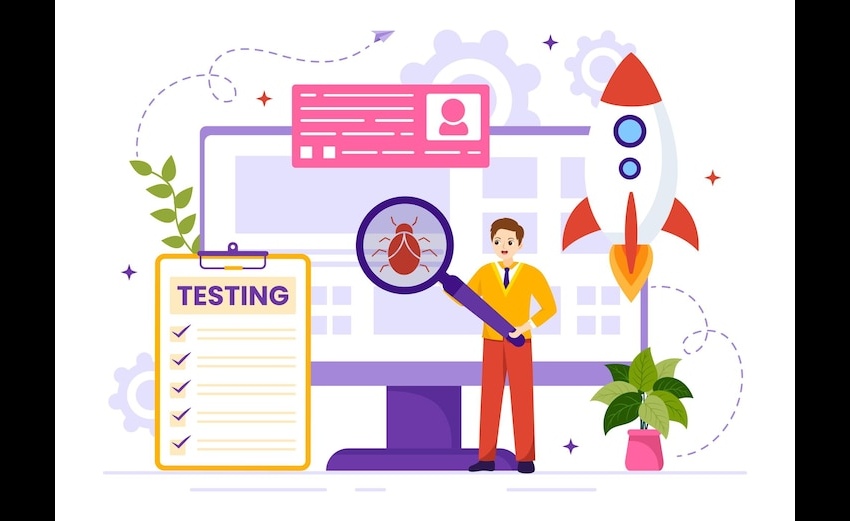Artificial Intelligence (AI) is quickly becoming a standard for software development and in the area of testing with a specific emphasis on review in testing. Review in software testing has in the past been a cumbersome process mainly involving manual intervention which they need a lot of time and needed effective cooperation from different team members. Still, currently, the use of AI techniques in the processes of review in testing assignments is occurring rapidly, which contributes to speeding up, increasing accuracy, and improving efficiency. So here, some of the ways by which AI is greatly improving review in testing and how exactly it revolutionizes quality assurance procedures are discussed.
What means “Review in testing”
Review in testing is the process of giving much attention on several aspects in the software testing process, which includes the code as well as the requirements and test cases with a goal of detecting some errors. This process plays an important role in guaranteeing that software that is produced and developed is of the highest quality, easily understandable and most importantly functional before it gets to the consumers.
Automated code Analysis and Defect detection
There is any number of methods with which AI is improving review in testing, and first among them is automated code analysis. AI enabled tools allow development teams to perform long scouring of code for bugs, exploits, and disparities in a live environment. These forms of artificial intelligent code reviews combines natural language processing to examine patterns of coding, then use machine learning algorithms to scan for problems like syntactical errors, performance issues and more importantly, security vulnerabilities.
Thus, instead of using review in testing methods where developers need to check manually for certain problems, AI tools make this check automatically and free developers’ time for coming up with creative ways for problem-solving and developing complex, logical algorithms. In those automated code reviews, the tools like SonarQube, CodeGuru, DeepCode has been widely used in industry as it helps to identify those problems very soon and keep the standard of code very high.
Applying NLP into Requirement Reviews
The crating and review in the testing process on requirements have been improved by the current advanced technological innovations in the AI NLP manifestation. AI with NLP can analyze requirements for the presence of ambiguity, shadiness, and incompleteness of the requirements thus helping with evaluation of the quality of the requirements as well as their relation to the goal of the project. It eliminates or, at least, minimizes the possibility of producing errors resulting from obscure specifications since it can easily identify such cases.
This stands favorable for Agile teams as the requirement herein is constantly reviewed while keeping the entire process clear. AI assisted requirement reviews also assist in eliminating confusion during the in testing phase of projects by afording all participants involved a clear understanding of needs and requirements for the porduct.
Introducing Machine Learning to improve the Test Case Reviewing process
AI can also greatly help when it comes to the review in testing process for test cases. Transformed historical test case data using machine learning algorithm to identify evaluation risks and propose amendments. There exist tools which are used in review of test results produced from the test cases where AI is applied and these include the following; Vendor Test Case Management which can be used to identify set of test cases that have been repeated, the Test Coverage Analysis which is aimed at highlighting the gaps within the test cases and recommend the effective test scenarios basing on the previous test results.
These AI tools can even get accustomed to previous testing cycles, know which kind of test cases gave positive results and was able to discover defects. This helps in reducing the time that is taken on proficiency or unnecessary test cycles, which improves the review in testing cycle for test cases and general productivity.
Real time feedback and review
Real time feedback is made possible by the use of AI, a major improvement for the review in testing when it comes to integration and deployment (CI/DC). While developers write code, AI starters work alongside indexing in real-time to recommend solutions and report problems before developers commit the code change. This makes it possible to always review as you go through the material and not wait till the time for the review session.
When feedback is in real time, the development teams can set high standards for themselves as they code and avoid issues that may end up in the later testing cycles. It increases the quality of developed code and at the same time reduces time and cost taken to fix problems arising after code release.
Dynamic Re-ranking Techniques for Reviewing Prioritization
Another advancement made in review in testing is the use of AI in predictive analytics. Through analysis of historical reviews, AI is capable of proactively or estimating sections of code that are most susceptible to including defects, which in turn helps testers prioritize the reviews. For instance, it is possible to predict that the code sections that are usually associated with more bugs or those that have been modified frequently should be reviewed more intensively while the most stable code should be reviewed with less intensity.
This prioritization feature makes it easier for testing teams to be able to spend more time on a particular area that calls for more testing. It therefore assists in the reducing the time taken in the review in testing process and also maximize the use of the resources while ensuring that critical defects are identified on time.
Enhancing Team Performance with the Assistance of AI Analytics
AI tools give information that aids relations among testing and development groups. It can capture reviewing trends, typical mistakes, and team performance so that managers obtain the information for increasing the efficiency of the review in the testing phase. For instance, AI knowledge may identify which code reviewers are particularly effective at identifying specific kinds of problems so that team managers can properly assign reviewers for the tasks.
These collaborative insights also make it easy to monitor how different projects are performing, thus making it possible for teams to be able to unearthing inefficiencies in the system. This data-centric strategy is well-suited in an AI framework because it nurtures collaboration through the reduction of work duplication and makes it easy to ensure that all members are on the same page regarding quality issues.
Conclusion
These changes are making the review in testing process faster, more accurate and most of all much more efficient than before. Automated coding tools, feedback tools, and predictive tools, all help testing teams to increase software quality and reduce error rates at lesser costs. With further development of AI technology it is seen that the review in the testing process will further incorporate into the software development lifecycle which will build even better solutions for testing that will in turn build even better products for the end users.
FAQ’s
How is artificial intelligence applied in testing reviews?
Review in testing is the process of giving much attention on several aspects in the software testing process, which includes the code as well as the requirements and test cases with a goal of detecting some errors. This process plays an important role in guaranteeing that software that is produced and developed is of the highest quality, easily understandable and most importantly functional before it gets to the consumers.
Which AI tools are frequently utilized in testing reviews?
Some of the most common AI tools used for reviewing code in testing include, SonarQube, DeepCode, and Amazon CodeGuru. This makes the review more efficient as these tools support analysis of code. Also identifies possible bugs and provides feedback in regard to the code.
How is artificial intelligence applied in testing reviews?
AI makes it easier to test in the sense that it performs parts of the review in the testing process. Such parts of review are scanning of the code for bugs, reformulating test cases and stating unclear requirements. AI tools give quick response, offer edits and even highlight regions that may likely contain problems.
What are the primary advantages of using AI in testing reviews?
AI accelerates reviews, identifies errors with great accuracy, and minimizes the burden on developers by automating a portion of the review process. It also offers the possibility of real time feedback, since problems are identified early and it can be corrected in a sooner stage of the program creation.
Can AI completely substitute manual review in testing?
This means that, although AI helps review during testing, there is still a need to have a separate review by other people. Despite that, it is still necessary to involve a human to make a judgment call on the design and features because AI cannot grasp a complex need that can be presented in words.

Software Testing Lead providing quality content related to software testing, security testing, agile testing, quality assurance, and beta testing. You can publish your good content on STL.



